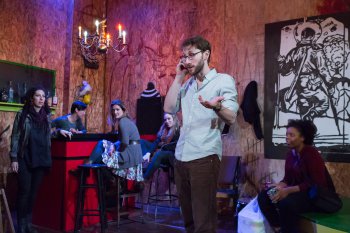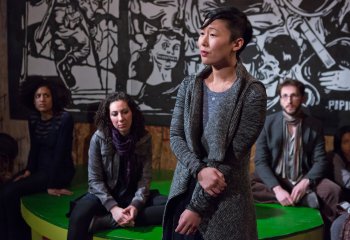The Place We Built
A rambling but ultimately moving portrait of young people fighting injustice in contemporary Hungary.

Tom Costello (center) and the company of “The Place We Built” (Photo credit: Hunter Canning)
[avatar user=”Joel Benjamin” size=”96″ align=”left” ] Joel Benjamin, Critic[/avatar]Sarah Gancher’s sprawling The Place We Built at The Flea, shines a bright, unflattering light on contemporary Hungary, in particular an illegal squat social club in the old Jewish section of Budapest which is the immediate subject of her play.
As Hungary took a turn to the extreme right in recent years, anti-Semitism and xenophobia not only raised their heads, but became de facto pillars of the new government. The Place We Built delves into the personal plight of an ad hoc blending of often contentious, mostly loving twenty-somethings who inadvertently wind up building and creating a meeting place of like minds in the old Jewish Ghetto and thereby defying and antagonizing the powers-that-be.
As more and more virulent anti-Semitic rhetoric fills Hungary, this bunch of young bohemians somehow have gravitated into the orbit of Ben (Tom Costello, skillfully playing a combination of reverie and nervousness) who has rediscovered his grandmother’s old apartment and its caught-in-amber mementos—wigs, furniture, diaries, letters, etc.—undisturbed since World War II.
Modern technology and a web of acquaintanceships quickly attract more and more of his friends and their friends—mostly Jewish students—to the apartment until they realize that the first floor of that building would make a perfect space for a café/performance venue. There they express their ardent left wing, anti-government opinions. They call it the Seagull (Siegel) as a tribute to Ron’s bubby (grandma).
Gancher organizes her play around the conceit of using a young, ex-pat American videographer, Aisha (Isabelle Pierre in a wonderfully matter-of-fact performance) to document this venue and the people who inhabit it and spread their message. As she catches each member of this circle in searching autobiographical monologues, we get their back stories—probably too many of them. We find that the magic of the Seagull attracts young people of various backgrounds, professions, religious fervor and political sensibilities. We watch as they face a thirty-six hour countdown to a face-off with the federal police who mean to not only arrest them, but impose physical violence and eradicate them and their den of iniquity. It is clear that their religion and their loud-and-clear expression of it (not to mention their anti-government rhetoric) is the motivating force in this de facto impending “mini-pogrom.”

Cleo Gray (center) and the company of “The Place We Built” (Photo credit: Hunter Canning)
It’s the fascinatingly troubled characters that form the backbone of Place. Each comes with a back-story that gravitated them to the Seagull, too many to mention here. Most appealing characters of the bunch: Aniko, a level-headed leader played appealingly by Leta Renée-Alan; Julia, tough and a tad sexually ambiguous, made literate and demanding by Cleo Gray; Zoltan, sensual and confident, embodied by a vibrant Ash McNair; Ilona (Tamara Del Rosso, playing cool and cruel with panache) who eventually betrays her friends; Szuszanna (a robust, appealing Lydian Blossom) who makes a few mistakes that lead her to motherhood; shy Mihaly (Brendan Dalton, making the most of both his slight physique and musical prowess) whose musical talents ingratiate him with the crowd who in turn empower him to self-knowledge; and the sexually and socially adventurous Kata (a charismatic, big-voiced Kristin Friedlander). Handsome Xavier Reminick makes several male roles vibrant and clearly individual.
In the end, though, The Place We Built turns out to be more of a theatricalized documentary than a play, however vivid, important, and revelatory its message. The conglomeration of episodes that keep tumbling over each other mainly to accumulate unnecessary background information lessens the thrust of the real drama—the imminent raid—at the expense of exposition. The play is held afloat by its determined, if motley, cast of fierce young actors.
The flexible Flea theater space is arranged into several playing areas representing the apartment, the Seagull, street scenes by scenic designers Arnulfo Maldonado and Feli Lamenca. Claudia Brown’s array of costumes captures both the raffish nature of these young protesters while keeping them individual. The imaginative lighting by Masha Tsimring skillfully brings the audience’s attention to the different playing areas as well as contributing to the mood of the play. Delightfully crude puppets, designed by Marte Johanne Ekhougen, are used in silly and profane agit/prop skits.
Director Danya Taymor did what she could to mold Gancher’s rambling play into a sustained drama and mostly succeeds.
Despite its faults, The Place We Built should be experienced by American theater-goers as a window on the ominous problems (seemingly) civilized Europeans live with every day while we snicker over our ever-more-depressing political and social scene.
The Place We Built (through May 23, 2016)
The Flea, 41 White Street, between Broadway and Church Street, in Manhattan
For tickets, call 212-362-3101 or visit http://www.theflea.org
Running time: two hours and 30 minutes including one intermission






Leave a comment